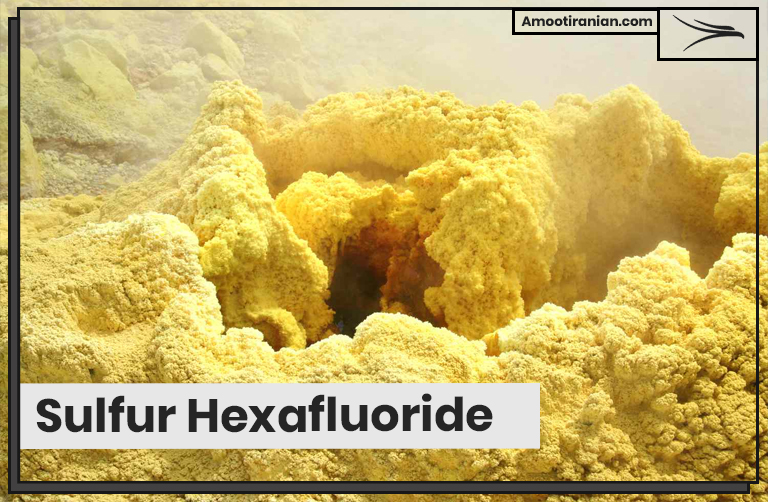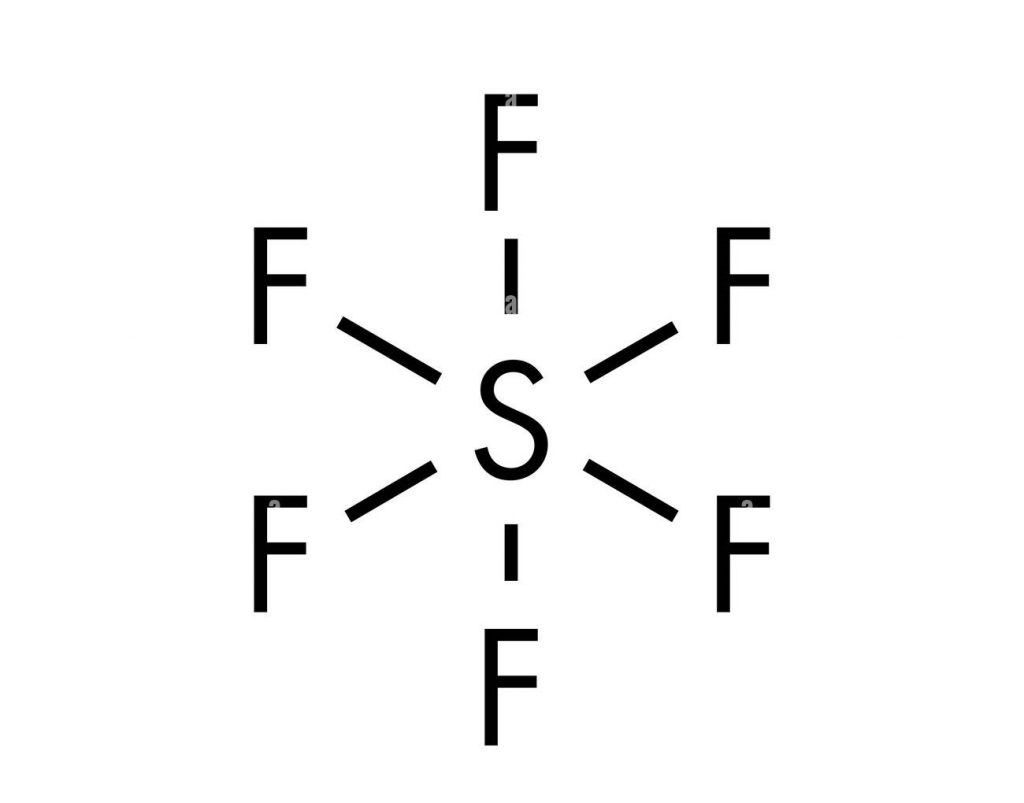.
What Is Sulfur Hexafluoride?
.
Sulfur hexafluoride (SF6) is a colorless, odorless, non-toxic, and non-flammable gas that is widely used in electrical industry as an insulating medium for high voltage equipment such as circuit breakers, switchgear, and transformers.
.
It has a high dielectric strength and excellent arc-quenching properties, making it an ideal choice for use in high voltage power transmission and distribution systems.
SF6 is also used in other industries such as medical and semiconductor manufacturing.
.
It is a potent greenhouse gas with a global warming potential (GWP) of 23,900 times that of carbon dioxide (CO2) over a 100-year time horizon, and its use is being gradually phased out due to its negative impact on the environment.
.

.
Sulfur Hexafluoride Formula
The chemical formula for sulfur hexafluoride is SF6. It is a colorless, odorless, and non-flammable gas that is commonly used in electrical transmission and distribution equipment, as well as in the production of semiconductor devices.
.

.
What Is Sulfur Hexafluoride Used for?
| Industry/Application | Use of SF6 |
| Electrical Power | Insulating gas in high-voltage power transmission and distribution equipment, such as switchgear, transformers, and circuit breakers. |
| Semiconductor Manufacturing | Process gas for etching and plasma cleaning of silicon wafers. |
| Leak Detection | Tracer gas for the detection of leaks in gas pipes, fittings, and equipment. |
| Medical Imaging | Contrast agent for ultrasound imaging of the heart and other organs. |
| Medical Treatment | Gas tamponade in the treatment of retinal detachment. |
| Metal Manufacturing | Cover gas in the production of magnesium and aluminum to prevent oxidation. |
.
It’s important to note that while SF6 has many useful applications, its negative impact on the environment as a potent greenhouse gas is causing a shift towards alternative solutions.
.
Is Sulfur Hexafluoride Harmful to Humans?
Sulfur hexafluoride (SF6) is generally considered to be a non-toxic gas and is not harmful to humans in its pure state. However, SF6 can displace oxygen in confined spaces and can cause asphyxiation if inhaled in high concentrations.
Therefore, it is important to use appropriate safety measures when working with SF6, such as ensuring proper ventilation and avoiding confined spaces.
In addition, although SF6 is not harmful to humans, it is a potent greenhouse gas with a global warming potential (GWP) of 23,900 times that of carbon dioxide (CO2) over a 100-year time horizon.
Its use is being gradually phased out in many industries due to its negative impact on the environment.
.
Here is the information organized in a table:
| Aspect | Information |
| Toxicity | Sulfur hexafluoride is generally considered to be a non-toxic gas and is not harmful to humans in its pure state. |
| Asphyxiation | SF6 can displace oxygen in confined spaces and can cause asphyxiation if inhaled in high concentrations. |
| Safety Measures | Proper ventilation and avoiding confined spaces are important safety measures when working with SF6. |
| Environmental Impact | SF6 is a potent greenhouse gas with a global warming potential (GWP) of 23,900 times that of carbon dioxide (CO2) over a 100-year time horizon. Its use is being phased out due to its negative impact on the environment. |
.
Is Sulfur Hexafluoride Safe to Breathe?
No, sulfur hexafluoride (SF6) is not safe to breathe.
SF6 is a colorless, odorless, non-toxic, and non-flammable gas, but it is classified as a potent greenhouse gas with a global warming potential thousands of times greater than carbon dioxide.
Inhaling SF6 can cause suffocation, dizziness, nausea, vomiting, and loss of consciousness.
SF6 is commonly used as an insulating gas in high-voltage electrical equipment, such as circuit breakers and transformers, because of its excellent electrical insulation properties.
However, it should only be handled by trained personnel in well-ventilated areas, and proper safety precautions should always be taken when using SF6 to prevent accidental exposure.
.
What Does Sulfur Hexafluoride Do to Your Voice?
Breathing in sulfur hexafluoride (SF6) can temporarily change the sound of a person’s voice.
SF6 is denser than air, so when inhaled and exhaled, it causes sound to travel at a slower speed through the lungs and vocal cords, resulting in a deeper, more resonant voice.
This effect is sometimes used for entertainment purposes, and SF6 is sometimes referred to as “the helium for the deep voice” or “the opposite of helium.” However, it is important to note that inhaling SF6 can be dangerous and should only be done under controlled and supervised conditions.
.
Is SF6 Worse Than CO2?
Sulfur hexafluoride (SF6) and carbon dioxide (CO2) are both greenhouse gases that contribute to global warming, but they have different levels of impact.
SF6 is a potent greenhouse gas with a global warming potential thousands of times greater than CO2.
However, SF6 is also present in much smaller quantities in the atmosphere than CO2.
The concentration of SF6 in the atmosphere is only about 0.0001 parts per million (ppm), while the concentration of CO2 is over 400 ppm.
CO2, on the other hand, is a naturally occurring gas that is essential for life on Earth.
However, human activities such as burning fossil fuels have significantly increased the concentration of CO2 in the atmosphere, leading to global warming and climate change.
In summary, while SF6 has a much greater global warming potential than CO2, the sheer amount of CO2 emissions produced by human activity means that CO2 is currently a much greater contributor to global warming than SF6.
That being said, both gases are problematic and efforts are needed to reduce their emissions.
.
Does SF6 Destroy Ozone?
No, sulfur hexafluoride (SF6) does not destroy ozone. SF6 is a man-made compound that does not contain chlorine or bromine, which are the primary culprits in the destruction of ozone in the stratosphere.
In fact, SF6 is often used as a substitute for ozone-depleting substances, such as chlorofluorocarbons (CFCs) and hydrochlorofluorocarbons (HCFCs), in applications such as refrigeration and air conditioning. By using SF6 instead of CFCs and HCFCs, we can help protect the ozone layer.
However, while SF6 does not destroy ozone, it is still a potent greenhouse gas that contributes to global warming and climate change.
Therefore, efforts are needed to reduce its emissions and find alternative solutions.
.
How Long Does SF6 Last?
Sulfur hexafluoride (SF6) is a very stable compound and has an atmospheric lifetime of up to 3,200 years, which means it can remain in the atmosphere for a very long time before being removed by natural processes.
Once released into the atmosphere, SF6 can contribute to global warming for many years.
However, it is important to note that the actual lifespan of SF6 in the atmosphere depends on a variety of factors, including the rate of emissions and the efficiency of removal mechanisms.
The primary removal mechanism for SF6 is through photolytic degradation, which occurs when the compound is exposed to sunlight and breaks down into its component gases. However, because SF6 is a very stable compound, this process is slow and relatively inefficient.
Overall, SF6 is a long-lived greenhouse gas that contributes to global warming, and efforts are needed to reduce its emissions and find alternative solutions.
